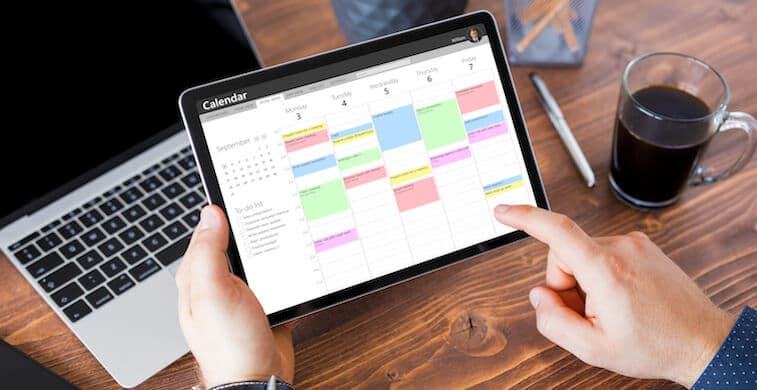Creating a weekly work plan increases your work performance and your chances of success. Instead of starting a new week simply hoping for the best, a plan ensures you have a strategy and schedule for completing your most important tasks.
This article shares all you need to know about creating a weekly work plan. We'll explain exactly what it is, the benefits, and the five steps you can take to create one for yourself.
What Is a Weekly Work Plan?
A weekly work plan is a high-level schedule for all you have to do in an upcoming workweek. It's an excellent work management technique, allowing you to plan and streamline your entire week's tasks to get the results you want.
Working with a weekly planner helps you navigate responsibilities in an efficient and systematic way without becoming overwhelmed or forgetting important action items. Your weekly work plan may be a breakdown of your monthly plan or a new one you create every week.
What Are the Benefits of a Weekly Work Plan?

Weekly work plans are a great way to enforce and practice time management. You list all you need to accomplish and assign everything to different days during the week, making sure you have enough time to complete each task.
This practice makes you feel prepared and all the more competent and confident at work. A few other benefits of weekly work plans include:
- Clarity: Weekly work plans break down your big goals into an ordered task list or weekly schedule with specific time slots and due dates. This helps you have a calmer, less cluttered mind and an efficient approach to completing your planned tasks and making progress on your professional goals each week.
- Work-life balance: Because you plan ahead, you can schedule your weekly work tasks in a way that complements your personal responsibilities and sets a clear time boundary between the two. This allows you to be fully present when it's time to focus on work and switch off completely when it's home and family time — which is especially useful for new remote workers who may be adjusting to a work-from-home schedule.
- High productivity and efficiency: A weekly work plan helps boost overall productivity and output at work. It also helps you define and streamline your workflows — improving your project management abilities and teamwork. You know what to do during every moment of your work hours or at least have a list of things to get done by the end of the week.
5 Steps to Develop a Practical Weekly Work Plan
Creating a weekly work plan is a straightforward process. Decide a time that you will do your weekly planning, either at the end of the previous week or on Sunday evening. Then, follow our five-step guide to customize your plan to meet your needs.
1. Choose Your Planning Tool
First things first, choose a planning tool that works best for you. You can use a pen and paper or a to-do list or calendar app on your phone. If you go with pen and paper, you can download a printable weekly planner template to guide your planning.
Using a pen and paper is a great way to avoid distractions from notifications on your phone. On the flip side, pen and paper is not as accessible as apps, which are always on your phone regardless of where you are.
You may need to test several options before deciding on the best fit for your needs. Look for a solution that fits into your lifestyle and isn't tedious. This way, you may actually look forward to your weekly planning sessions.
2. List All Your Tasks
Make a master list of your tasks for the next week. This can include tasks you didn’t complete during the current week and any meetings or time-specific responsibilities.
3. Time Block Your Tasks Using Your Planning Tool

Now that you have your list of tasks and responsibilities, break up your week into time blocks and decide which tasks will be handled during each block of time. As you work through this planning stage, you’ll want to be conscious of your energy levels and batch smaller or similar tasks together.
First, be mindful of your energy levels as you allot tasks to time blocks. Schedule the most important tasks at times when you're sharp and focused with peak-level energy. Also, try not to schedule too many demanding tasks in one workday. This can quickly lead to reduced productivity.
Instead, balance your days with tough and easy tasks to avoid burnout. In addition, don’t forget to schedule breaks into your plan.
Once you have time blocked for your important, energy-intensive tasks and for your time-specific responsibilities, focus on the smaller, non-essential tasks you need to tackle during the week.
These may be “little” things like catching up on industry news and growing your professional network on social media. They are important to professional growth but not directly related to your job role. Or this may be your administrative responsibilities like handling emails, returning phone calls, and responding to messages on Slack.
Batch these tasks in sizable chunks and schedule multiple time slots during the workweek to complete them. This will help you limit context switching and ignore distractions during blocks where deep focus is needed.
To keep your weekly planning simple, you can schedule conditional time slots for these batched tasks. This means these time slots are adjustable. When they roll around in real time, you can decide if you should work on them or focus on something else more urgent or valuable that may have cropped up during the week.
In addition to time blocking, you can also incorporate other productivity systems, like the Pomodoro or Eat the Frog techniques.
4. Stick to the Plan
Stick to the plan as much as possible to reinforce the habit. If you make a weekly work plan and fail to follow through, you won't meet your objectives and may lose confidence in yourself and your abilities. The more you create and use weekly work plans, the better you get at it, and the more your productivity and efficiency at work improve.
Develop realistic plans, especially when you're just beginning, and give yourself time to catch up to full speed. Feel free to share your plan or calendar with team members you work closely with to let them know when you're free or busy.
5. Reflect, Refresh, Repeat
Take time to reflect at the end of the week. If you didn't complete some tasks, check with yourself to know why you didn't. Use what you learn about your experience each week to create a better plan for the following week.
A time management tool can help you track how you spent your time in comparison to your plan. For example, Rize will automatically track your work hours, focus time, and breaks to help you analyze how well you stuck to your plan so you can make adjustments going forward.
Plan Your Week More Effectively With Rize
Planning your workweek gives you clarity, improves your productivity, and lets you maintain a work-life balance. When you use the above five steps to create and optimize your weekly work plan, you’ll be able to start your Monday mornings knowing exactly what to do and how to spend your time for the rest of the week.
You can make your planning even more impactful by adding a time tracker like Rize to help you understand how you actually spend your time. Having this data will allow you to better plan your time blocks and improve your focus.
Want to get better at planning your workweeks to enhance productivity? Start your two-week free trial of Rize.
